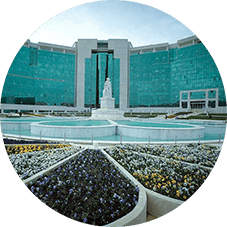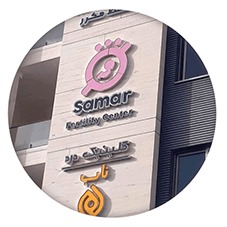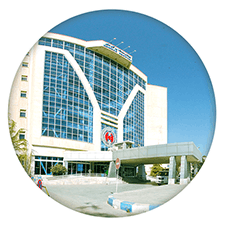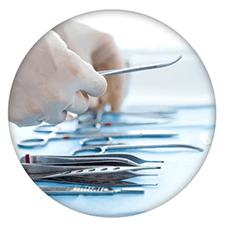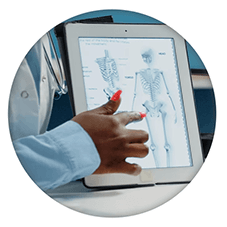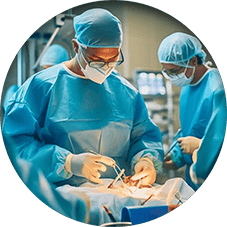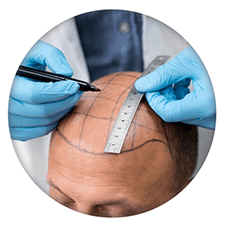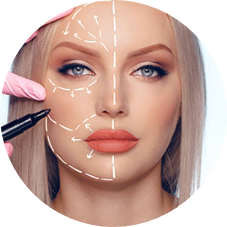Chalazion Treatment in Iran
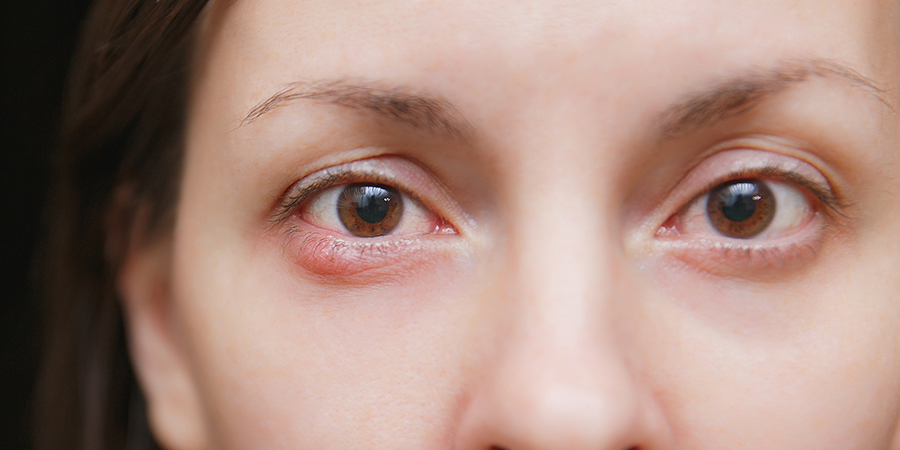
Chalazion surgery involves removing a chalazion, a rubbery, hard, painless bump or swelling that can occur in the upper or lower eyelid, although the upper eyelid is more common. Chalazia (plural of chalazion) is caused by a blockage of an oil-producing gland in the eyelid called the meibomian gland.
Often, chalazion surgery is not necessary because chalazion (especially in small cases) will go away on its own within a few days to a few weeks. But when they persist, or are large and cause symptoms such as blurred vision or eye irritation, surgical removal may be indicated. Chalazion surgery is performed by an ophthalmologist or oculoplastic surgeon, a doctor who specializes in plastic and reconstructive surgeries involving the eyelids and certain areas of the face.
While this surgery, the surgeon makes an incision in the eyelid and removes the oily contents of the chalazion or chalazia with a surgical instrument called a curette.
This surgery may be performed on adults or children. Local anesthesia or general anesthesia may be needed, although general anesthesia is more common in children.
Sometimes a chalazion may be assumed to be a stye. The main differences are that chalazia are usually painless, while calluses are more sensitive, redder, and generally show more signs of inflammation. Also, styes are usually located at the eyelid margin, where chalazia occur on the eyelid and away from the edges.
Generally, any type of eye surgery depending on its sensitivity needs very high-tech equipment and professional eye surgeons, chalazion treatment is not an exception. Chalazion treatment in Iran based on its high demand will be done very professionally. The best clinics and hospitals in Iran are providing the most exceptional and perfect eye treatment services to patients for any need. Chalazion treatment in Iran also follows these exceptional and perfect treatment services.
Happy Green Life health tourism agency, in association with the best surgeons and eye treatment centers, provides the most unique special services along with the treatments for patients’ convenience. In the following, with a more precise look, you will find out why Iran must be your priority to choose as a destination for your chalazion treatment.
Chalazion Treatment in Iran
With the recent significant development that Iran has experienced in medical and cosmetic treatments, for the time being, a huge number of patients are visiting Iran for treatments from all over the world each year.
Plus, everyone probably knows about the famous historical background of medical treatments in Iran. Due to the U.S sanctions against Iran, Iran’s currency has experienced a big collapse and the costs of medical and cosmetic treatments in Iran also face a huge cheapness like the costs of everything else. Chalazion treatment in Iran follows this cheapness. People who are facing chalazion may now understand that the best option available for them is having their chalazion treatment in Iran. Because the mentioned reasons are enough to bring every patient to Iran for treatment.
There are also many active health tourism agencies working days and nights to provide the best services to patients. One of these health tourism agencies is Happy Green Life. Happy Green Life with a strong background as a medical and cosmetic treatments provider works with the best eye treatment clinics and hospitals in Iran.
Now that you have been informed about the benefits of having chalazion treatment in Iran and working with Happy Green Life agency, we will take a closer look into the chalazion treatment and everything about it.
What are the symptoms of a chalazion?
- A painless bump in your eyelid, usually on the upper eyelid.
- Mild burning that causes watery eyes.
- Blurred vision caused by larger chalazia pressing on the eyeball.
How is chalazion diagnosed?
- Health History: Provide your complete health history. The details that will be exposed by you can help your doctor find underlying issues that could be contributing to the formation of a chalazion.
- External eye exam: Your doctor will examine your eyes, eyelids, eyelashes, and skin texture.
- Full eyelid exam: Ophthalmologists look at the base of your eyelashes with intense light and magnification. They also check the opening of the oil glands.
Can chalazion be prevented?
You may prevent chalazion by maintaining good hygiene. Some essential important elements of good hygiene are:
Hand washing: Wash your hands thoroughly and regularly before touching your eyes.
Contact lens care: Wash your hands before removing the lens. Be sure to thoroughly wipe and clean your contacts with a disinfectant and lens cleaning solution. Always discard daily and time-limited contacts on schedule.
Washing your face: Before going to bed, wash your face every day to remove dirt and makeup. Your healthcare provider may recommend that you clean your eyelids with a special scrub or baby shampoo, especially if you’re prone to blepharitis.
Makeup hygiene: Throw always away expired makeup. Be sure to change mascara and eye shadow every two to three months. Also, never share or use someone else’s makeup.
Contraindications
- A chalazion is located near the pinna (the small opening in the corner of the eye where tears flow).
- Inability to remain still, although sedation may be recommended until surgery is performed
- Allergy or sensitivity to anesthesia
Possible risks
- General risks of surgery (example: bleeding, infection, bruising)
- Recurrence of chalazion or creation of new chalazion
- A cut or depression of the eyelid
- Misaligned or abnormally positioned eyelids (trichiasis)
- eyelash loss
- eye damage
- eyelid scar
Purpose of Chalazion Surgery
Chalazion surgery is performed to reduce the symptoms and any negative effects of eyelid protrusion on the patient.
In particular, surgery may be recommended in the following cases:
- Chalazion persists despite non-surgical treatments (warm compress on the eye, gentle eyelid massage, prescription steroid ointment).
- A chalazion/eyelid is infected and does not heal with antibiotics
- A chalazion is large and causes symptoms (such as blurred or reduced vision, astigmatism, watery eyes, and eye discomfort).
Keep in mind that during evaluation for chalazion surgery, your doctor may suggest an alternative, less invasive treatment—injecting a corticosteroid into the chalazion.
Steroid injections for chalazia are meant to reduce inflammation and the resulting redness, swelling, and tenderness. While considered safe and potentially beneficial, permanent skin lightening may occur around the injection site
If chalazion surgery is performed, more medical clearance will likely be required if general anesthesia is planned. This clearance can usually be done through a visit to a pediatrician or primary care physician.
How to Prepare?
At the preoperative appointment, the doctor will go over the steps involved in your surgery, including the preparation and recovery processes.
Location
Chalazion surgery is performed in an office setting, ambulatory surgery center, or hospital. The last two are the only places where a procedure involving general anesthesia can be performed.
What to wear
Wear comfortable and free clothes on the day of surgery. You might want to wear a shirt or blouse that buttons or zips up the front so you don’t have to pull it over your head at the end of the day when you’re home.
If general anesthesia is planned, it is best to wear something easy to take off or put on again, as you will need to change into a hospital gown upon arrival.
Finally, on the day of surgery, avoid wearing makeup. If you usually wear contact lenses, make sure that you wear glasses that day.
Food and drink
If you are under general anesthesia, avoid eating or giving the child any food after midnight on the eve of surgery. Clear liquids may be allowed up to two hours before your scheduled check-in time.
Medications
Patients may take their usual medications on the day of surgery. But there are exceptions, including drugs that may increase the risk of bleeding, such as nonsteroidal anti-inflammatory drugs (NSAIDs).
Check with your doctor to be sure about every precaution. Before surgery, tell your doctor about all the medications you are taking, including prescription and over-the-counter medications, dietary supplements, herbal remedies, and recreational drugs.
What should I bring?
On the day of surgery, bring your birth certificate and insurance card. Also, have someone with you to drive you home after the procedure.
If your child is having surgery, consider bringing a stuffed animal or favorite toy to help them relax after the procedure.
Lifestyle changes before surgery
For adults undergoing general anesthesia, quit smoking as soon as possible before surgery.
What to Expect on the Day of Surgery?
Here’s what you can generally expect before, during, and after chalazion surgery.
Before surgery
Upon arrival at the hospital, doctor’s office, or surgery center, you will be directed to a small pre-op/holding area. If you are receiving general anesthesia, you will be asked to wear a hospital gown at this time. A nurse places a line in your arm.
Your doctor will then meet you and briefly review the procedure with you. From there you go to the operating room. If your child is having chalazion surgery under local anesthesia, he may be given a sedative to help him fall into a deep sleep at first.
During the Surgery
The surgery takes up to 45 minutes.
Here’s how to perform a procedure using local anesthesia:
- Numbing the area: The surgery begins with an injection of anesthetic into your eyelid around the area of the chalazion. You may feel a burning sensation and some discomfort during the injection.
- Positioning and Incision: Your surgeon uses a clamp to hold your eyelid open when the procedure is being done. Then, based on the size of the chalazion, the surgeon will make a small incision in front or behind the eyelid. If there is a large chalazion, the incision is generally made in front of the eyelid.
- Removal: Cort is then used to remove the contents of the chalazion. A cotton swab is placed over the wound to stop any bleeding. Then the clip is removed and the doctor puts pressure on the wound with the pads of his fingers.
Typically, the incision site will be left to heal. But if a large chalazion is removed, the surgeon may stitch the incision.
The contents of the chalazion may be sent to the laboratory, especially if the chalazion has been present for a long time or is recurrent. A pathologist examines the contents to rule out potential eyelid cancers.
After surgery
If you are under local anesthesia, you can go home immediately after the operation.
If you are under local anesthesia with sedation or general anesthesia, you will be taken to the recovery area to slowly wake up. After you are fully awake and ready, you will be discharged home with post-operative instructions.
Recovery
- Eyelid discomfort, bruising, and swelling
- A little blurry vision
- Minimal red liquid oozing from the surgical site
- Use a cold compress on the eye from time to time to decrease swelling
- Take acetaminophen for any eyelid discomfort
- Use antibiotic eye ointment or drops to help prevent infection
- Avoid contact lenses, touching your eyes, and using eye makeup to help prevent infection
- Avoid heavy lifting, bending, and vigorous activity to help reduce bruising
- Use an eye patch that you can remove on your own the morning after surgery
Long-term care
Although recovery from chalazion surgery is relatively short, your eyelid may remain slightly inflamed for several weeks. As a result, your doctor may ask you to come back a few months after your surgery to make sure everything has resolved.
For the long term, you also want to try and prevent new chalazia from forming.
Helpful habits to consider include:
- Adopt a daily eyelid cleaning regimen: Use baby shampoo or pre-moistened eyelid cleansing pads to gently wash the edge of your lids (where the eyelashes come out).
- The habit of washing hands regularly, especially before touching the eyes
- If you wear contact lenses, clean them properly and dispose of disposable lenses as scheduled
- If you wear makeup, replace your eye shadow, eyeliner, and mascara every two months, and clean your eye makeup brush every two weeks with mild dish soap or baby shampoo.
In some cases, certain complementary therapies may be recommended to help win over eyelid inflammation, such as omega-3 supplements. Be sure to use these treatments only under the guidance of your doctor.
Possible future surgeries
Future surgical interventions may be required if new chalazion develops and/or if surgical complications develop.
Summary
If you think you have chalazion, try not to worry too much. In the vast majority of cases, these eyelid bumps get better with simple home remedies.
If you end up needing surgery, the good news is that your results should be excellent.
Chalazion in Iran with Happy Green Life
If you have had a Chalazion for several months, you should consider Chalazion Treatment. It can start to interfere with your vision. So, it is always better to act quickly. Choose the best treatment and the best specialists for a job. Health tourism is an excellent answer for you. Contact Happy Green Life and ask us whatever you wish to know. We are ready to provide you with the best hospitals, great practitioners, and affordable prices. It’s a choice not only changes your Look but also will prevent any potential damage to your eyes regarding chalazion. Iran is at the top of the Middle East eye care because of its services. You will be treated with international standards. That’s why Iran is the best destination to get the best eye care treatments.
Frequently Asked Questions
Does chalazion appear on both eyelids?
Yes, a chalazion can appear on both eyelids. A chalazion can appear in the upper and lower eyelids of each eye, or a single eyelid can be affected by multiple chalazia.
Can you get rid of chalazion fast?
By following these treatment steps, you may be able to get rid of chalazion quickly.
- Use a warm, moist compress on the chalazion three to six times a day, at 5-to-10-minute intervals.
- Use an over-the-counter ointment or medicated pad.
- If the chalazion opens on its own, avoid touching it.
- Avoid wearing contact lenses.
If none of these steps resolve the chalazion, it may be a good idea to contact a healthcare professional. They may give you prescription medication or suggest surgery to help get rid of it.
Are there chalazion eye drops?
Yes, antibiotic eye drops are used to treat chalazion. However, you will likely need a prescription. If this treatment does not get better and recover, the surgeon may recommend surgical removal.
You can always have access to all our services in one place, Click here!

